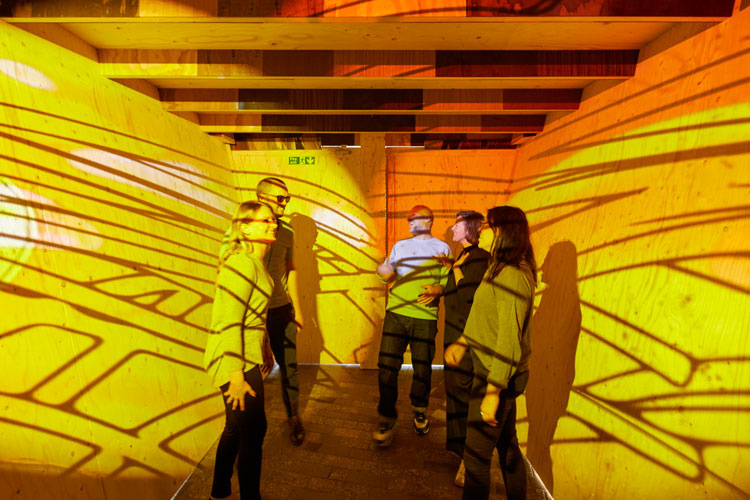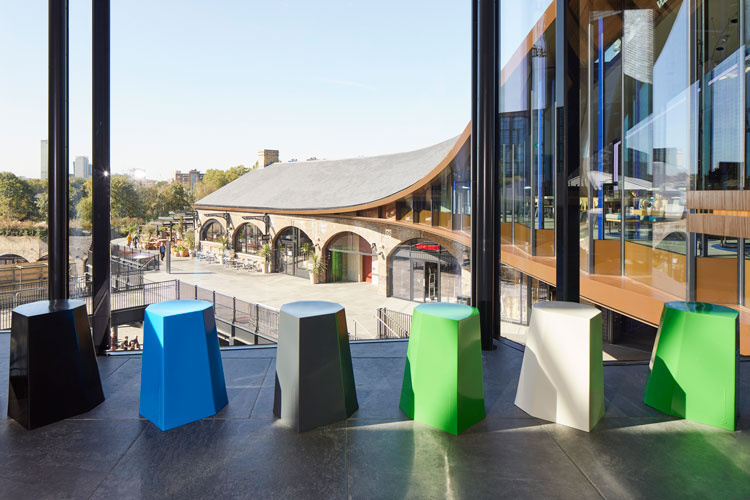Understanding Martino Gamper’s “ironic” disco at Coal Drops Yard
His installation for London Design Festival draws on a number of inspirations, from clubbing in the 1990s to fake Crimean villages.

A fake disco takes over Coal Drops Yard this week as part of London Design Festival (LDF). While it may seem random — and it is intended to be playful — Martino Gamper’s set piece brings together relevant concepts to the future of installation design.
The festival’s remit this year is sustainability, which is an obvious tension with installations that only last a week; a virtual design, which uses augmented reality, is the focus of one of the V&A’s installations. The idea of something temporary was Gamper’s starting point.
He was inspired by the concept of a “fake buildings” and a major influence was the 1984 LA Olympics. For the games, graphic designer Deborah Sussman and architect Jon Jerde, Gamper created film-set like installations — fitting given the city’s Hollywood association — which were made from scaffolding.
Gamper also began to research the story of Gregory Potemkin. Potemkin was an 18th century governor of Crimea who wanted to impress his lover, Catherine the Great. On her tour of the region, he would set up fake villages to give the impression of a burgeoning society. “He fooled her with the idea of a fake empire, where everything is perfect,” Gamper says.
“I wanted to bring back the idea that the area isn’t just a shopping mall”
Gamper’s piece is of a smaller-scale than Potemkin’s villages, but the installation similarly plays with ideas of anticipation and deception. People queue up and approach the colourful inspiration to find a tunnel with disco music playing. Once they walk through, they find out that there’s nothing there — it’s only an exterior. As well as adding an “ironic” touch of humour to its surroundings, the conceptual piece aims to make users think about urban design and sustainability.
The disco of the title refers to Gamper’s experience of clubbing in the area in the 1990s. Gamper, who was born in Italy and studied sculpture and product design in Vienna, moved to London in 1988 to study at the Royal College of Art. He has lived in London ever since and has close ties with the capital. “I wanted to bring back the idea that the area isn’t just a shopping mall,” he says. “It can be a social place for meeting and culture.”

Carbonara, meanwhile, takes its name from the Italian pasta dish — a hearty, cheap option favoured by coal miners in Italy — as a nod to its location at Coal Drops Yard.
The façade is made from off-cuts produced by Alpi. The Italian company stains broken down poplar and lime wood create a material veneer that mimics the look of exotic wood. For Disco Carbonara, the off-cuts from this more environmentally friendly process have been glued together to create a multi-coloured surface. This created a “patchwork” effect for the installation, which compliments the idea of a brightly-lit disco.
“I like niche objects that aren’t iconic pieces”
This is a banner year for Gamper at LDF. There will also be an exhibition providing insight into three of the designer’s projects. Idiosincratico presents Gamper’s exhibition Hookalotti and Metamorfosi, a celebration of Italian furniture company Moroso, where he splices their past designs. It will also unveil a new edition of his Arnold Circus Stool, a modular chair he designed for the regeneration of one of London’s oldest estates, the Boundary Estate in Shoreditch.

With Hookalotti, Gamper explores the “simple and mundane” hook, which are “overlooked by the design world.” It has been in the works for three years and allowed Gamper to explore working with clay, ceramics as well as other materials like wrought iron.
“I like niche objects that aren’t the iconic pieces,” the designer says about the exhibition, which gives him the rare opportunity to explore design conceptually before working on commercial designs.
“You learn a lot when you play”

In 2007, Gamper made a new chair every day for 100 days as part of his exhibition, 100 Chairs in 100 Days. This resulted in a diverse line-up, from humorous mash-ups to designs that influenced eventual commissions. “I think it’s important to not give up a sense of fun in the research period,” Gamper says. “You learn a lot when you play.”
His next project is about something less superficially glamorous: waste bins. “As soon as you consume anything, it produces rubbish,” he says.
“I remember doing a show in Turin, where I lived in a house for two months and worked only from there. All I had was a bed in the space, but I realised the first object I needed — over a table or chair — was a bin.”
Disco Carbonara and Idiosincratico run from 14-22 September 2019 at Coal Drops Yard, Kings Cross, London N1C 4DQ.
-
Post a comment




